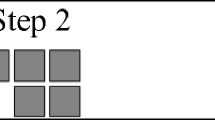Abstract
The purpose of this paper is to explore middle school in-service mathematics teachers’ ability (1) to identify and explain students’ actions in pattern generalization and (2) to account for the variation in teachers’ explanations of students’ actions in terms of task and teachers’ factors. Two questionnaires were developed: (1) a questionnaire to measure teachers’ ability to identify students’ actions while finding the nth term in the pattern generalization and (2) a questionnaire to measure teachers’ ability to explain students’ actions in different tasks. The two questionnaires were given to a sample of 83 middle school in-service mathematics teachers from 22 schools in Lebanon. Analysis of data shows that teachers seemed to have the ability to identify students’ actions while finding the nth term in the pattern generalization and that teachers’ explanations of students’ actions in different tasks are lacking in terms of identifying variable-related counting elements. The results of stepwise multiple regression show that teachers’ ability to explain students’ actions to find the general term depends on their ability to explain students’ step-by-step counting or drawing.



Similar content being viewed by others
References
Amit, M., & Neria, D. (2008). “Rising the challenge”: Using generalization in pattern problems to unearth the algebraic skills of talented pre-algebra students. ZDM, 40, 111–129.
BouJaoude, S., & El-Mouhayar, R. (2010). Teacher education in Lebanon: Trends and issues. In K. Karras & C. C. Wolhuter (Eds.), International handbook of teacher education world-wide (Vol. 2, pp. 309–332). Athens: Atrapos Editions.
Chua, B. L., & Hoyles, C. (2009). Generalisation and perceptual agility: How did teachers fare in a quadratic generalising problem? Proceedings of the British Society for Research into Learning Mathematics, 29(2), 13–18.
De Bock, D., van Dooren, W., Jannsens, D., & Verschaffel, L. (2002). Improper use of linear reasoning: An in-depth study of the nature and the irresistibility of secondary school students’ errors. Educational Studies in Mathematics, 50, 311–334.
Dörfler. (2008). En route from patterns to algebra: Comments and reflections. ZDM, 40, 143–160.
English, L., & Warren, E. (1998). Introducing the variable through pattern exploration. Mathematics Teacher, 91(2), 166–170.
Harel, G., & Tall, D. (1991). The general, the abstract and the generic in advanced mathematics. For the Learning of Mathematics, 11(1), 38–42.
Kaput, J. (1999). Teaching and learning a new algebra with understanding. In E. Fennema & T. A. Romberg (Eds.), Mathematics classrooms that promote understanding (pp. 133–155). Mahwah: Lawrence Erlbaum.
Krebs, A. (2005). Studying students’ reasoning in writing generalizations. Mathematics Teaching in the Middle School, 10(6), 284–287.
Lannin, J. (2003). Developing algebraic reasoning through generalization. Mathematics Teaching in the Middle School, 8(7), 342–348.
Lannin, J., Barker, D., & Townsend, B. (2006). Algebraic generalisation strategies: Factors influencing student strategy selection. Mathematics Education Research Journal, 18(3), 3–28.
Mason, J. (1996). Expressing generality and roots of algebra. In N. Bednarz, C. Kieran, & L. Lee (Eds.), Approaches to algebra: Perspectives for research and teaching (pp. 65–86). Dordrecht: Kluwer Academic.
National Council of Teachers of Mathematics. (2000). Principles and standards for school mathematics. Reston: NCTM.
Polya, G. (1954). Induction and analogy in mathematics. Princeton: Princeton University Press.
Radford, L. (2000). Signs and meanings in students’ emergent algebraic thinking: A semiotic analysis. Educational Studies in Mathematics, 42, 237–268.
Radford, L. (2008). Iconicity and construction: A semiotic investigation of forms of algebraic generalizations of patterns in different contexts. ZDM, 40, 83–96.
Rivera, F. (2010). Visual templates in pattern generalization activity. Educational Studies in Mathematics, 73, 297–328.
Rivera, F., & Becker, J. R. (2007). Abduction–induction (generalization) processes of elementary majors on figural patterns in algebra. The Journal of Mathematical Behavior, 26, 140–155.
Rivera, F., & Becker, J. R. (2008). Middle school children’s cognitive perceptions of constructive and deconstructive generalizations involving linear figural patterns. ZDM, 40(1), 65–82.
Rivera, F., & Becker, J. R. (2009). Algebraic reasoning through patterns. Mathematics Teaching in the Middle School, 15(4), 212–221.
Smith, M., Silver, E., & Stein, M. (2005). Improving instruction in algebra: Using cases to transform mathematics teaching and learning (Vol. 2). New York: Teachers College Press.
Stacey, K. (1989). Finding and using patterns in linear generalising problems. Educational Studies in Mathematics, 20, 147–164.
Steele, D. (2008). Seventh-grade students’ representations for pictorial growth and change problems. ZDM, 40, 55–64.
Steele, D., & Johanning, D. (2004). A schematic–theoretic view of problem solving and development of algebraic thinking. Educational Studies in Mathematics, 57, 65–90.
Swafford, J. O., & Langrall, C. W. (2000). Grade 6 students’ preinstructional use of equations to describe and represent problem situations. Educational Studies in Mathematics, 31, 89–112.
Van de Walle, J. (2007). Elementary and middle school mathematics: Teaching developmentally (6th ed.). Boston: Allyn and Bacon.
Yeap, B.-H., & Kaur, B. (2008). Elementary school students engaging in making generalisation: A glimpse from a Singapore classroom. ZDM, 40, 55–64.
Zazkis, R., & Liljedahl, P. (2002). Generalization of patterns: The tension between algebraic thinking and algebraic notation. Educational Studies in Mathematics, 49, 379–402.
Acknowledgments
This research was supported by a grant from the University Research Board at the American University of Beirut.
Author information
Authors and Affiliations
Corresponding author
Rights and permissions
About this article
Cite this article
El Mouhayar, R.R., Jurdak, M.E. Teachers’ ability to identify and explain students’ actions in near and far figural pattern generalization tasks. Educ Stud Math 82, 379–396 (2013). https://doi.org/10.1007/s10649-012-9434-6
Published:
Issue Date:
DOI: https://doi.org/10.1007/s10649-012-9434-6




